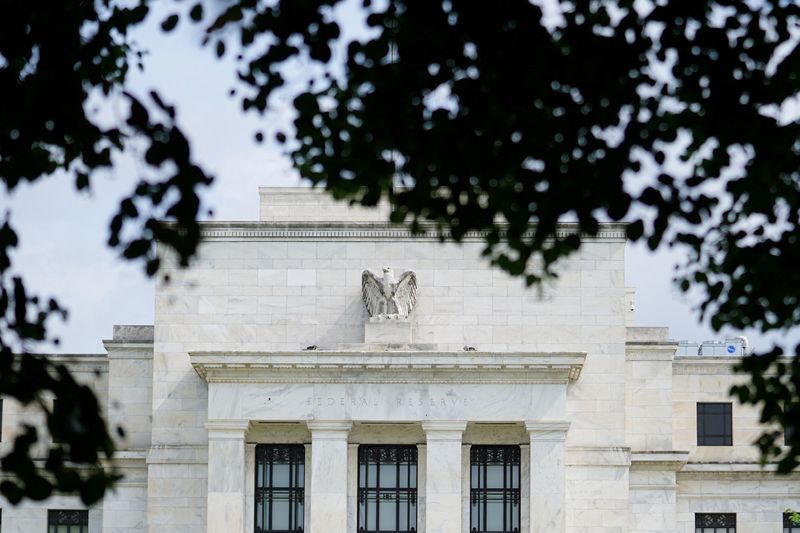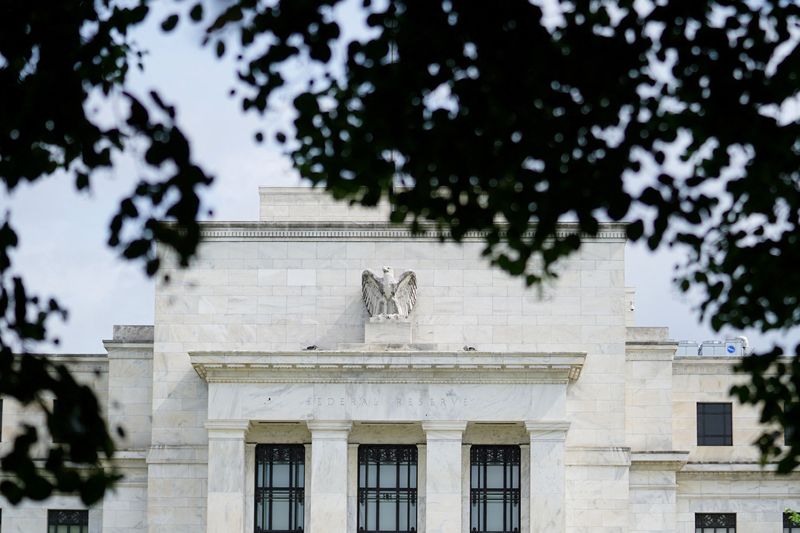Economy
Fed to leave rates unchanged on Sept. 20; cut unlikely before Q2 2024: Reuters poll


© Reuters. FILE PHOTO: The exterior of the Marriner S. Eccles Federal Reserve Board Building is seen in Washington, D.C., U.S., June 14, 2022. REUTERS/Sarah Silbiger/File Photo
By Prerana Bhat
BENGALURU (Reuters) – The Federal Reserve will leave its benchmark overnight interest rate unchanged at the end of its Sept. 19-20 policy meeting and probably wait until the April-June period of 2024 or later before cutting it, according to economists in a Reuters poll.
Fed Chair Jerome Powell underscored the “higher-for-longer” mantra for rates in a speech at the annual Jackson Hole central banking symposium in August and maintained another rate hike might still be needed to bring inflation down to the 2% target.
But other members of the rate-setting Federal Open Market Committee (FOMC), including some of the more hawkish ones, have raised the possibility of holding off on another rate hike to allow more time to gauge the impact of the cumulative 525 basis points of tightening delivered by the Fed since March 2022.
More than 95% of economists, 94 of 97, in the Sept. 7-12 Reuters poll predicted the U.S. central bank would hold the federal funds rate in the current 5.25%-5.50% range next week, in line with market expectations.
Still, nearly 20% of the economists, 17 of 97, predicted at least one more rate rise before the end of the year, including three who expected one this month.
“Though we continue to expect the Fed to remain on hold at the Sept. 20 FOMC meeting, we would not be surprised to see most officials continue to project one more rate hike by year-end in their updated ‘dot plot,'” said Brett Ryan, senior U.S. economist at Deutsche Bank, referring to the interest rate projections released by Fed policymakers on a quarterly basis.
“While there has been meaningful progress to date on inflation … the Fed will not be able to take this for granted.”
Much of the immediate outlook for Fed policy will depend on the release on Wednesday of Consumer Price Index (CPI) data for August. The CPI was expected to have risen 0.6% last month, after a 0.2% rise in July, according to economists polled by Reuters. If realized, that would mean an acceleration in the annual rate to 3.6% from 3.2%.
JOB MARKET
The unemployment rate rose to 3.8% in August, raising hopes among those who don’t want to see another rate hike that the U.S. labor market was finally cooling.
But the Reuters poll of economists forecast that the jobless rate would average 3.7% this year and rise only slightly to 4.3% in 2024, suggesting the Fed even then will not be far off its goal of full employment.
House prices and rents were also expected to remain elevated now that a relatively brief U.S. housing market correction appears to be over, according to a separate Reuters poll.
That may put the brakes on further declines in inflation, which is not predicted to reach the Fed’s target until at least 2025.
That suggests rate cuts may still be a long way off.
Of the 87 respondents who had forecasts until the middle of 2024, 28 put the timing of the first rate cut in the first quarter and 33 had it in the quarter after that. Only one said the Fed would cut rates this year.
Around 70% of those respondents, 62 of 87, had at least one rate cut by the end of next June. Still, all but five of 28 respondents to an extra question said the bigger risk was that the first Fed cut would come later than they currently forecast.
“Tight labor and housing markets present upside risk to inflation … That means that absent a recession, policymakers are likely to keep policy rates on hold well into 2024,” said Andrew Hollenhorst, chief U.S. economist at Citi.
A serious economic downturn could justify an earlier rate cut, but that is looking less likely. The economy was expected to expand by 2.0% this year and 0.9% in 2024, according to the poll.
The median view from a dwindling sample of economists who provided responses on the probability of a recession within one year fell further to 30%, after tumbling below 50% for the first time in nearly a year last month. It peaked at 65% in October 2022.
“In our base-case forecast, the economy enters recession in the first half of next year, which would have the Fed cutting by Q2. But the risk is that growth holds up and the first cut is pushed out later,” Citi’s Hollenhorst said.
(For other stories from the Reuters global economic poll:)
Economy
Russian central bank says it needs months to make sure CPI falling before rate cuts -RBC


© Reuters. Russian Central Bank Governor Elvira Nabiullina attends a news conference in Moscow, Russia June 14, 2019. REUTERS/Shamil Zhumatov/File Photo
MOSCOW (Reuters) – Russia’s central bank will need two to three months to make sure that inflation is steadily declining before taking any decision on interest rate cuts, the bank’s governor Elvira Nabiullina told RBC media on Sunday.
The central bank raised its key interest rate by 100 basis points to 16% earlier in December, hiking for the fifth consecutive meeting in response to stubborn inflation, and suggested that its tightening cycle was nearly over.
Nabiullina said it was not yet clear when exactly the regulator would start cutting rates, however.
“We really need to make sure that inflation is steadily decreasing, that these are not one-off factors that can affect the rate of price growth in a particular month,” she said.
Nabiullina said the bank was taking into account a wide range of indicators but primarily those that “characterize the stability of inflation”.
“This will take two or three months or more – it depends on how much the wide range of indicators that characterize sustainable inflation declines,” she said.
The bank will next convene to set its benchmark rate on Feb. 16.
The governor also said the bank should have started monetary policy tightening earlier than in July, when it embarked on the rate-hiking cycle.
Economy
China identifies second set of projects in $140 billion spending plan


© Reuters. FILE PHOTO: Workers walk past an under-construction area with completed office towers in the background, in Shenzhen’s Qianhai new district, Guangdong province, China August 25, 2023. REUTERS/David Kirton/File Photo
SHANGHAI (Reuters) – China’s top planning body said on Saturday it had identified a second batch of public investment projects, including flood control and disaster relief programmes, under a bond issuance and investment plan announced in October to boost the economy.
With the latest tranche, China has now earmarked more than 800 billion yuan of its 1 trillion yuan ($140 billion) in additional government bond issuance in the fourth quarter, as it focuses on fiscal steps to shore up the flagging economy.
The National Development and Reform Commission (NDRC) said in a statement on Saturday it had identified 9,600 projects with planned investment of more than 560 billion yuan.
China’s economy, the world’s second largest, is struggling to regain its footing post-COVID-19 as policymakers grapple with tepid consumer demand, weak exports, falling foreign investment and a deepening real estate crisis.
The 1 trillion yuan in additional bond issuance will widen China’s 2023 budget deficit ratio to around 3.8 percent from 3 percent, the state-run Xinhua news agency has said.
“Construction of the projects will improve China’s flood control system, emergency response mechanism and disaster relief capabilities, and better protect people’s lives and property, so it is very significant,” the NDRC said.
The agency said it will coordinate with other government bodies to make sure that funds are allocated speedily for investment and that high standards of quality are maintained in project construction.
($1 = 7.1315 renminbi)
Economy
Russian central bank says it needs months to make sure CPI falling before rate cuts -RBC


© Reuters. Russian Central Bank Governor Elvira Nabiullina attends a news conference in Moscow, Russia June 14, 2019. REUTERS/Shamil Zhumatov/File Photo
MOSCOW (Reuters) – Russia’s central bank will need two to three months to make sure that inflation is steadily declining before taking any decision on interest rate cuts, the bank’s governor Elvira Nabiullina told RBC media on Sunday.
The central bank raised its key interest rate by 100 basis points to 16% earlier in December, hiking for the fifth consecutive meeting in response to stubborn inflation, and suggested that its tightening cycle was nearly over.
Nabiullina said it was not yet clear when exactly the regulator would start cutting rates, however.
“We really need to make sure that inflation is steadily decreasing, that these are not one-off factors that can affect the rate of price growth in a particular month,” she said.
Nabiullina said the bank was taking into account a wide range of indicators but primarily those that “characterize the stability of inflation”.
“This will take two or three months or more – it depends on how much the wide range of indicators that characterize sustainable inflation declines,” she said.
The bank will next convene to set its benchmark rate on Feb. 16.
The governor also said the bank should have started monetary policy tightening earlier than in July, when it embarked on the rate-hiking cycle.

 Forex3 years ago
Forex3 years agoForex Today: the dollar is gaining strength amid gloomy sentiment at the start of the Fed’s week

 Forex3 years ago
Forex3 years agoUnbiased review of Pocket Option broker

 Forex3 years ago
Forex3 years agoDollar to pound sterling exchange rate today: Pound plummeted to its lowest since 1985

 Forex3 years ago
Forex3 years agoHow is the Australian dollar doing today?

 Cryptocurrency3 years ago
Cryptocurrency3 years agoWhat happened in the crypto market – current events today

 World3 years ago
World3 years agoWhy are modern video games an art form?

 Commodities3 years ago
Commodities3 years agoCopper continues to fall in price on expectations of lower demand in China

 Economy3 years ago
Economy3 years agoCrude oil tankers double in price due to EU anti-Russian sanctions

























